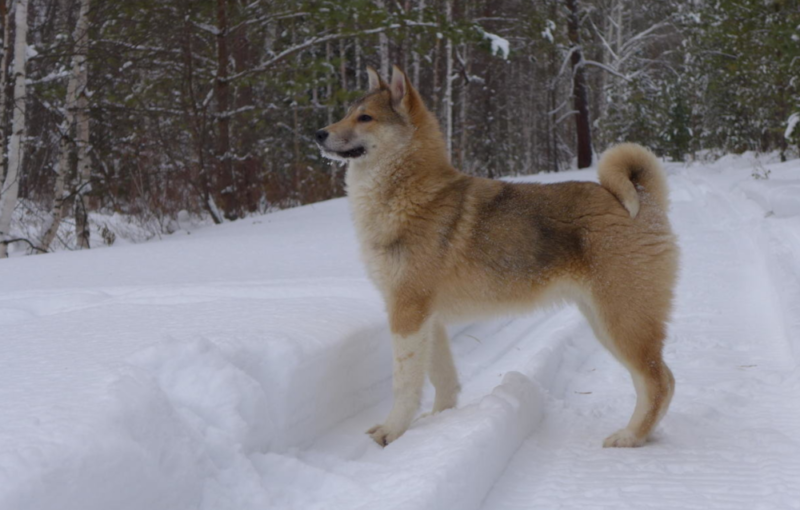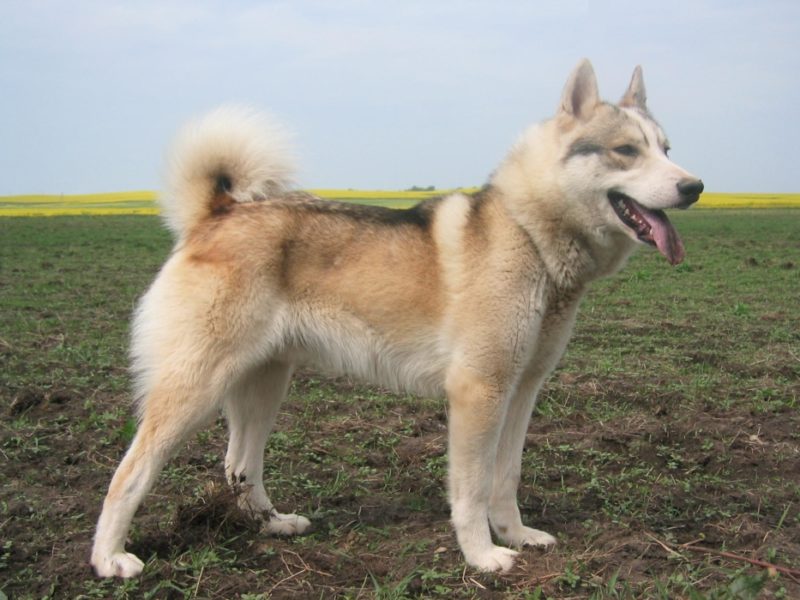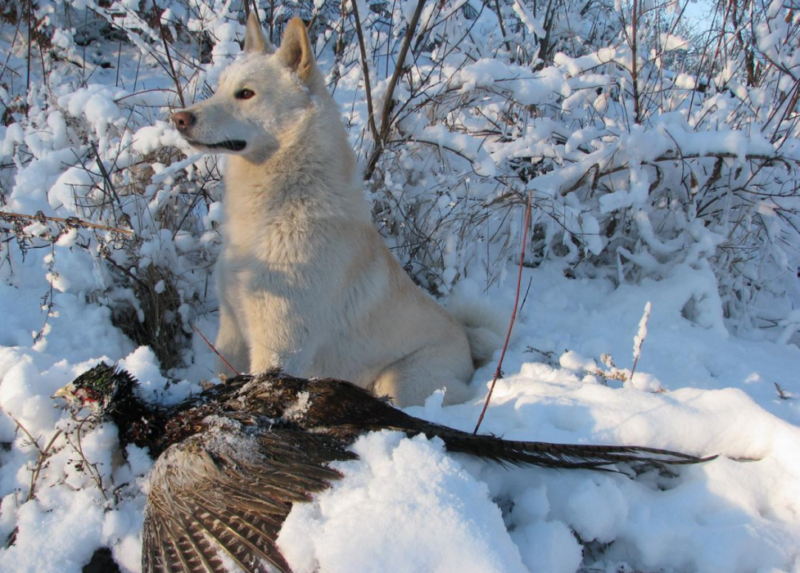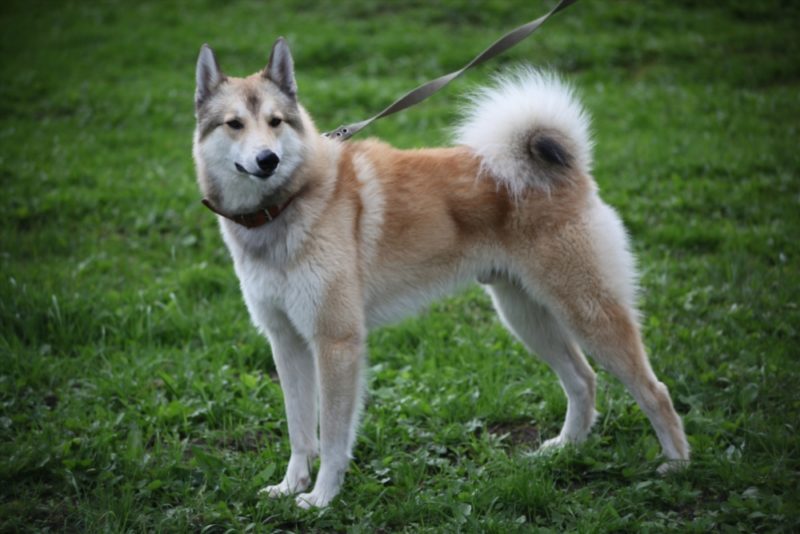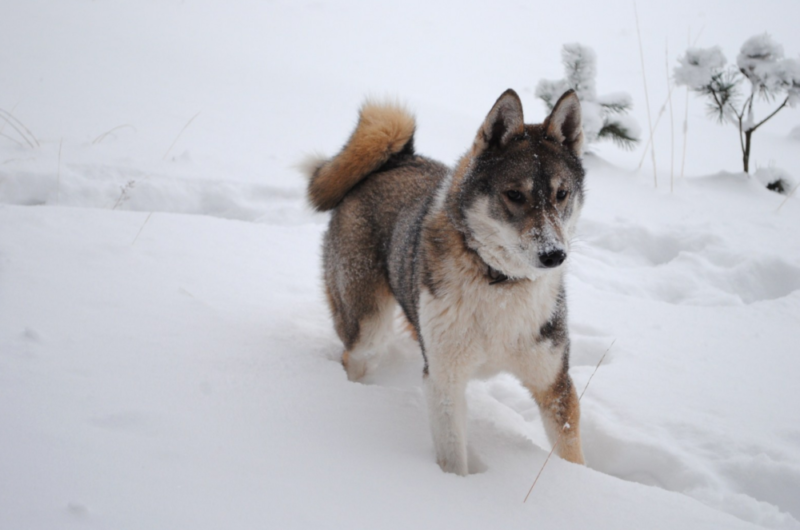West Siberian Laika (ZSL) is an extremely hardy hunting dog breed that can adapt to any climate conditions. The main task of the dog is to catch up with the beast and bark to notify the owner of the location of the prey. Due to its versatility, the breed is popular all over the world, and in Russia it is rightfully considered a national treasure.
Material Content:
Description and characteristics of the breed
ZSL is a close relative of the wolf, both in appearance and in habits. In the process of development, the breed was divided into two large groups according to their exterior characteristics: Khanty and Mansi.
The first is distinguished by large ears, a somewhat elongated head, a pointed muzzle, rounded eyes and taller growth.
The Mansi type of huskies is characterized by short stature, strong physique, a “wolf” neck, small ears and an oblique section of the eyes.
One of the main behavioral characteristics of the breed is considered absolute fearlessness, bordering on the complete disregard for danger.
The peculiarity of the origin does not pose any threat to humans, since the animal demonstrates the harsh character only in relation to game. In the family, the West Siberian husky manifests itself as a cheerful, active, cheerful creature. The dog chooses one owner whom he loves selflessly, obeys, and also unquestioningly fulfills his commands (even not very logical). Children and other pets are welcome.However, if he meets relatives or cats on the street, he will certainly pursue “prey”, so such attempts should be immediately stopped.
West Siberian huskies have a high level of intelligence: work skills are literally passed on to them by inheritance. And also they are well oriented on the ground.
Origin history
Zsl - one of the oldest breeds of dogs. It is believed that the first mention of it is found on frescoes from the time of Ancient Russia.
The homeland of huskies is called the territory of the Urals and Siberia. Indigenous peoples - Khanty, Mansi and Zyryans - with the help of the northern "wits" were engaged in furs. Weak animals incapable of hunting or running in a harness were discarded. In this case, only the most powerful individuals remained, which were used in breeding.
The breed standard was first described in 1925 at a congress of dog handlers. The popularity of animals began to grow gradually.
During the Great Patriotic War, West Siberian huskies participated in battles and delivered goods.
The species standard was finally approved only in 1952, after which the number of professional dog kennels increased.
And in 1980, the International Kennel Federation (IFF) officially recognized the breed.
Life span
On average, the life span of West Siberian huskies is 10–12 years, but under good conditions, dogs often reach 16–17 years.
Exhausting work, on the contrary, adversely affects the duration of the life cycle of animals. It also happens that huskies die in the prime of life, entering into an unequal battle with a large beast. This happens especially often when the lynx becomes the subject of prey.
Dog's purpose
The main purpose of the West Siberian husky is hunting.
The versatility of the dog allows you to use it in various directions of fishing:
- solitary, doubles and naughty;
- on a lynx;
- on large animals (wild boar, elk or bear);
- on a small beast (hare, squirrel, badger).
Laika drives the ungulates, tracks down predators, searches for waterfowl and raises it on the wing for a shot. The small animals that the dog detects, it simply does not allow to escape, while warning about the prey of the owner. Zsl is also considered the best bear hunter.
According to professionals, females of this breed are ideal for hunting birds or furs. They are more calm, faithful and neat. They do not go far from the owner and have clear, far-reaching, strong voices.
Males are much stronger, more resilient and more aggressive, therefore they are better suited for bullying a large beast. In pursuit of prey, males often run long distances, where they can not be heard due to a weaker bark.
As a pet, experts do not recommend starting such an individual. Even if you play sports with your pet, he will not be able to completely “throw out” the accumulated energy and his working qualities, likes will suffer.
The watchman from the dog also does not work, because they do not have a sense of territoriality.
West Siberian husky standard
ZSL is an animal of strong physique, medium in size, with well-developed skeleton and muscles.
Sexual dimorphism is inherent in the breed: females are much smaller and weaker than males.
According to the generally accepted standard, West Siberian huskies differ in the following characteristics:
- the head is a wedge-shaped type, proportionately folded (with respect to the body), with an elongated skull and a noticeably protruding mound on the back of the head;
- the back is muscular, straight, strong and not very wide;
- lips - without bryly, tight fitting;
- the nose is small, mostly black;
- ears are high, erect, pointed;
- cheekbones - poorly developed;
- jaw - with a scissor bite;
- eyes - oval, small, deep set, brown;
- the chest is wide, oval, long;
- paws - muscular, round;
- belly - matched;
- tail - with a ringlet;
- the coat is coarse, thick, with a plentiful soft undercoat.
The average weight of the dog varies between 16–22 kg, the height of the animal (depending on gender) does not exceed 60–65 cm. Moreover, according to the standard, it is very important that the pet is proportionately folded. The male sacrum should be 1-2 cm above the shoulder line, and 1 cm lower for the “girl”.
West Siberian huskies are similar in appearance to wolves, therefore the main color is “wolf”.
And shades are also allowed:
- ginger;
- gray;
- reddish brown;
- fawn;
- white flowers.
There are individuals with zonal color or piebald (interspersed in the above shades).
Disqualifying breed characteristics are:
- aggression or cowardice;
- deviations in behavior;
- twisted jaws;
- bite problems;
- lack of 4 teeth or more;
- extra incisors;
- unusual color of the cornea;
- hanging ears;
- uncharacteristic shape of the tail (saber, sultan, rod);
- short or excessively long hair;
- genetic brown, blue or brindle colors.
According to the standard, the male must have two testicles fully descended into the scrotum.
Features of the content in the city and the countryside
The main requirement for the conditions of keeping a husky is the availability of free space. The best option for an animal is considered to be living in a rural aviary. At the same time on the chain to keep the dog categorically forbidden. Pets should be able to move freely at any time.
For the same reason, the West Siberian husky in the city, living in an ordinary apartment, can suffer and even get sick. In a limited area, the dog begins to show destructive tendencies and may behave inappropriately. In addition, the dense coat of animals is intended to survive in harsh climatic conditions, and the housing content of the pet will lead to almost year-round molting. To minimize the possibility of such problems, ZSL needs daily active walks for 4–5 hours, as well as constant sports. Although hunting is still an ideal exercise for the animal.
Care and Feeding
West Siberian huskies are not picky about food. If necessary, they can even completely do without food for some time. However, a balanced diet is the key to good health of the pet and its good performance.
Ideally, the diet of an adult dog should consist of the following ingredients:
- lean meats;
- offal;
- boneless sea fish;
- some vegetables;
- fermented milk components;
- chicken or quail eggs;
- croup.
West Siberian husky puppies can be given mashed boiled vegetables and a mixture of milk with egg yolk. As they grow older, chopped raw meat, bread, rice (boiled), fat and bone meal should be added to their menu.
In order to avoid health problems and to maintain excellent physical shape, it is necessary to arrange a fasting day for dogs on breadcrumbs and water once a week.
It is undesirable to feed a pet:
- smoked meats;
- pork;
- sweets;
- nuts and dried fruits;
- pasta
- potatoes
- garlic and onion;
- bean.
Two meals a day will be able to completely replenish the energy expended by the animal during the day.
In addition to feeding, a husky needs other “care” procedures:
- Twice a week she is combed with a metal comb. During molting, dead hairs are removed with a furminator or a special slicker.
- They bathe animals only if necessary (for example, before contests).
- Claws are cut every 30 days with a special device designed for large breeds of dogs.
- Daily examine eyes for the absence or presence of turbid discharge. Transparent “tears” do not need care, and the gray lumps in the corners of the eyes are cleaned with a cotton pad dipped in a solution of chamomile.
- Ears are also examined daily for inflammation and periodically wiped with a damp cotton swab to remove dust and sulfur.
- 6 After walking, the animal’s paws and body are examined to detect injuries, cracks or parasites.
Be sure to periodically visit the veterinarian for preventive examinations of the dog, as well as its vaccination and deworming.
Training and education
The education of freedom-loving and independent huskies begins with building trusting relationships and defining a hierarchy. The dog must feel in the owner of the leader and leader. Only in this case, the animal will unconditionally obey the owner.
The next stage of training is the study of prohibitions and basic obedience commands. Before starting to perfect professional skills, ZSL gets acquainted with such teams as “sit,” “lay,” “aport” and others.
Huskies begin to develop working qualities after the change of milk teeth in the animal. For this, the pet is taken to the forest. Typically, a dog is first dragged onto a squirrel. It is enough to stretch the carcass of the animal on the ground, and then throw it on a tree. At the command of the animal, obeying the strength of natural inclinations, begins to "pursue" the prey.
It is strictly forbidden during the training to yell at the like or use physical punishment. Representatives of this species may hold a grudge.
Advantages and disadvantages of the breed
The breeders include the positive qualities of West Siberian huskies:
- devotion;
- friendliness;
- unpretentiousness;
- cleanliness;
- love for children.
The disadvantages of the breed are:
- stubbornness;
- the need for long walking;
- increased need for communication.
West Siberian huskies are active and cheerful animals, ideally suited to participation in various hunting directions. Proper education and quality care is the key to their long and full life.


